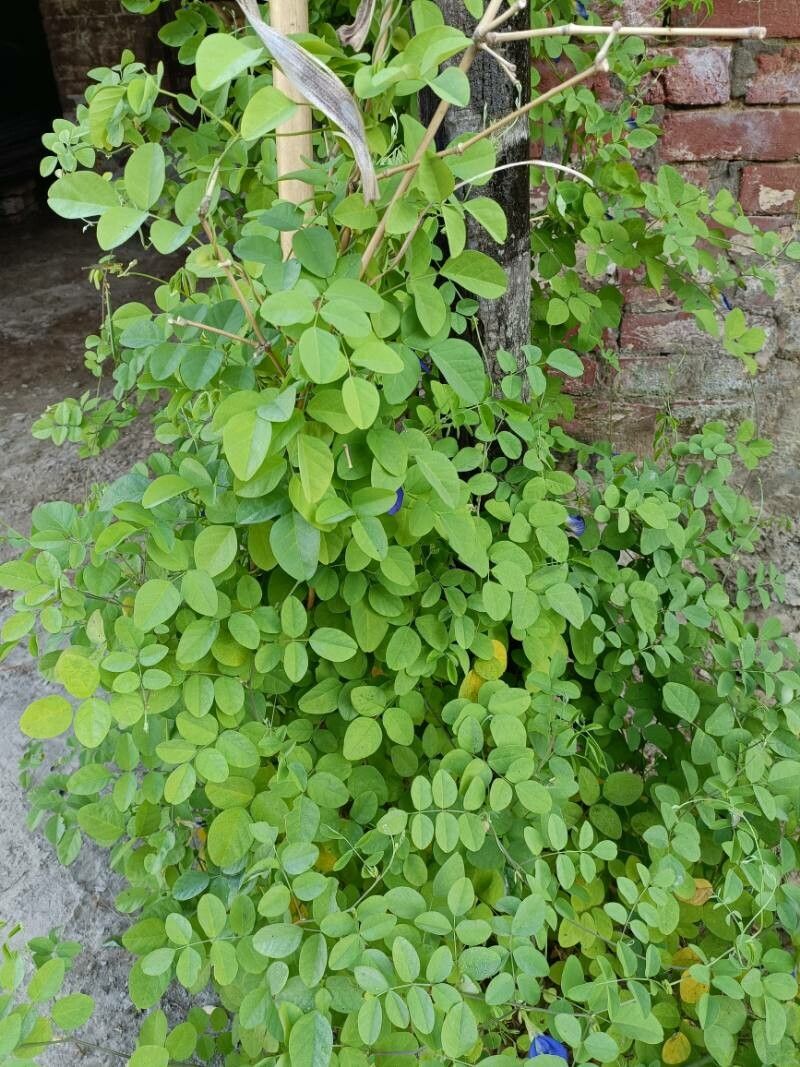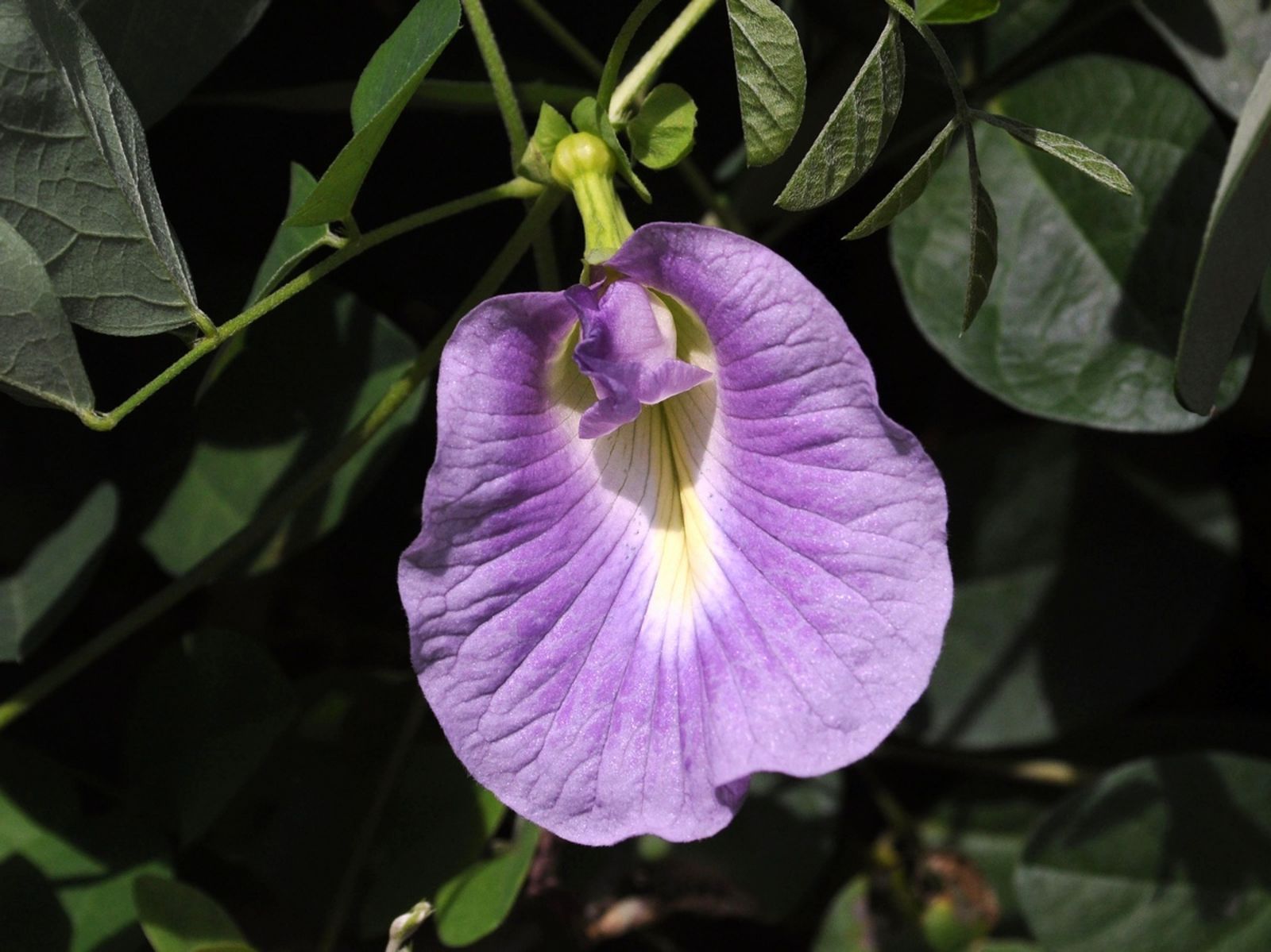Butterfly Pea
clitoria ternatea
Also known as: ["Asian pigeonwings","blue pea","bluebell vine","Butterfly pea vine","Dermijntje"]
Overview
A tropical, twining vine with striking blue flowers and trifoliate leaves, native to Southeast Asia.
Benefits & Perks
["long-flowering","fragrant flowers","wildlife attractant (bees, butterflies, birds)","drought tolerant"]
Botanical Classification
| Phylum: | Magnoliophyta |
| Class: | Magnoliopsida |
| Order: | Fabales |
| Family: | Fabaceae |
| Genus: | Clitoria |
| Botanical Name: | Clitoria ternatea |
Plant Characteristics
Basic Information
- Category: Flowers
- Suitable Location: outdoor garden bed in tropical or subtropical regions, or as a container plant in temperate climates
- Suitable For:
- Is Weed: No
- Allergenicity: low
Environmental Needs
- Climate: {"temperatureRange":"20–35°C"}
- Hardiness: {"zones":"9–11"}
- Misting: rarely required, only if ambient humidity is very low
- Drainage: Fast-draining to prevent waterlogging.
- Soil Type: Well-draining, loamy soil with organic matter.
Maintenance Level
- Maintenance Level: moderate
- Toughness Level: moderate
- Pruning Frequency: As needed, typically every 2–3 months or after flowering.
- Pruning Intensity: Moderate; remove up to one-third of growth if overgrown.
Care Details
Ideal Sunlight Coverage:
Full sun (6–8 hours/day); tolerates partial shade in intense heat.
Sunlight Tolerance Tips:
Acclimate gradually to full sun to prevent leaf burn; provide afternoon shade in hot climates; ensure good air circulation.
Care Requirements
Care Difficulty
moderatemoderate
Sunlight
full sun to partial shade
Morning sun is ideal; rotate plant for even growth; avoid direct midday sun in summer.
Watering
every 7–10 days, allowing soil to dry slightly between waterings
Water deeply to encourage root growth; allow soil to dry between waterings; avoid overwatering.
Soil
well-draining, loamy soil with moderate organic content
pH: Slightly acidic to neutral (pH 6.0–7.0).
Use a mix of potting soil and perlite; avoid heavy clay soils; ensure pots have drainage holes.
Temperature
Warm temperatures (65–85°F/18–29°C); sensitive to frost.
Protect from frost; avoid sudden temperature swings; maintain warmth during dormancy.
Fertilizing
every 4–6 weeks during active growing season with balanced liquid fertilizer
Fertilize during active growth; avoid over-fertilizing; flush soil occasionally to prevent salt buildup.
Propagation
Methods
Stem cuttings or division.
Step-by-Step Propagation Guide
- Take a 4–6 inch cutting.
- Remove lower leaves.
- Dip in rooting hormone.
- Plant in medium.
- Keep moist.
Best Time: Spring or early summer when plant is actively growing.
Environment
Warm, humid, and bright indirect light; protect from direct sun.
Medium
Well-draining potting mix with perlite or sand.
Hormone
Optional, but recommended for faster rooting.
Timeline
Roots in 2–4 weeks; establish in 2–3 months.
Tools Needed
Pruning shears, rooting hormone, small pots, misting spray bottle.
Quick Tips
Use healthy, non-flowering stems; maintain high humidity; avoid overwatering.
Pruning & Repotting
Pruning Guide
Method
Pinch back tips or cut stems just above a leaf node.
Pruning Plan
Remove dead or leggy growth to encourage bushier, more compact plants.
Tools
Pruning shears, sharp knife, gloves.
Checklist
Sterilize tools; prune dead/damaged growth; shape plant; clean up debris.
Repotting Guide
Best Season
Spring, before new growth begins.
Pot Size
One size larger pot (e.g., +2–3 inches in diameter).
Method
Remove plant gently; trim roots if needed; place in new pot with fresh soil; water lightly.
Suggestions
Repot every 1–2 years or when roots fill the pot; beneficial for growth and flowering.
Checklist
Choose appropriate pot; prepare new soil; handle roots carefully; water after repotting.
Advanced Care Tips
Watering Mastery
Watering Checklist
Check soil moisture; water deeply; ensure proper drainage; adjust for season.
How to Apply Water Properly
Water at the base of the plant, ensuring even moisture distribution; water until it drains from the bottom; avoid wetting foliage to prevent fungal issues.
Watering Schedule Tips
Water thoroughly when the top inch of soil feels dry; reduce frequency in winter to prevent root rot.
Soil Improvement
Add perlite or sand for drainage; incorporate compost for fertility; ensure good aeration.
Temperature Stress Management
Signs of Temperature Issues
Wilting, yellowing leaves, stunted growth, or bud drop in extreme conditions.
Cold Stress
Slows growth, causes leaf drop, and may lead to death in prolonged cold.
Solution: Move to a warmer location; cover with frost cloth; avoid watering during cold snaps.
Hot Stress
Leaf scorch, wilting, and reduced flowering in excessive heat.
Solution: Provide shade during peak heat; increase humidity; water early morning or late evening.
Fertilizing Guide
Fertilizing Checklist
Check fertilizer type; dilute properly; apply during growing season; avoid winter feeding.
Fertilizing Method
Balanced liquid fertilizer diluted to half strength every 4–6 weeks during growing season; reduce or stop in winter.
Common Problems & Solutions
Toxicity Warning
Cats
Non-toxicClitoria ternatea is not considered toxic to cats. The plant does not pose a significant risk to feline health when ingested in typical amounts.
⚡ Toxic If:
Generally not toxic
Dogs
Non-toxicClitoria ternatea is not considered toxic to dogs. The plant is not known to cause adverse effects when ingested in small quantities.
⚡ Toxic If:
Generally not toxic
Humans
Non-toxicClitoria ternatea, commonly known as butterfly pea flower, is generally considered non-toxic to humans. It is widely used in culinary applications, particularly in Southeast Asian cuisine, as a natural food coloring and in traditional herbal remedies.
⚡ Toxic If:
Generally not toxic
Frequently Asked Questions
Q: Is Butterfly Pea vine edible?
A: Yes, the flowers are used in cooking, particularly for their natural blue color in teas and desserts.
Q: How do I grow Butterfly Pea vine?
A: Plant in full sun, well-drained soil, and provide support for climbing. It thrives in warm climates.
Q: Does Butterfly Pea vine attract pollinators?
A: Yes, it attracts bees, butterflies, and birds due to its vibrant flowers and nectar.
Quick Reference
| Family: | Fabaceae |
| Care: | moderate |
| Light: | full sun to partial shade |
| Water: | every 7–10 days, allowing so |
Get Expert Care Tips
Download the Plantious app for personalized care reminders and plant identification!
Google Play App Store








